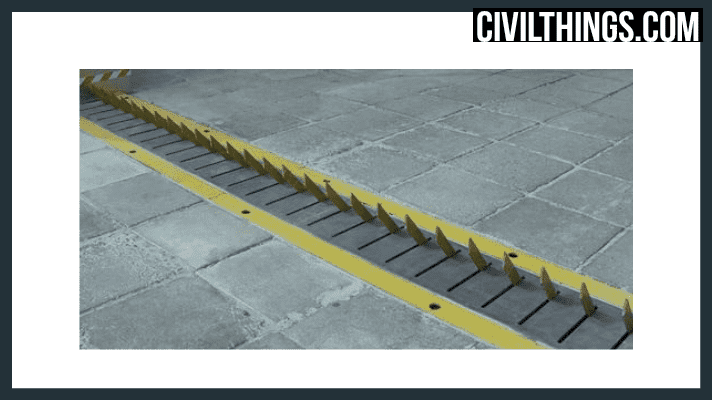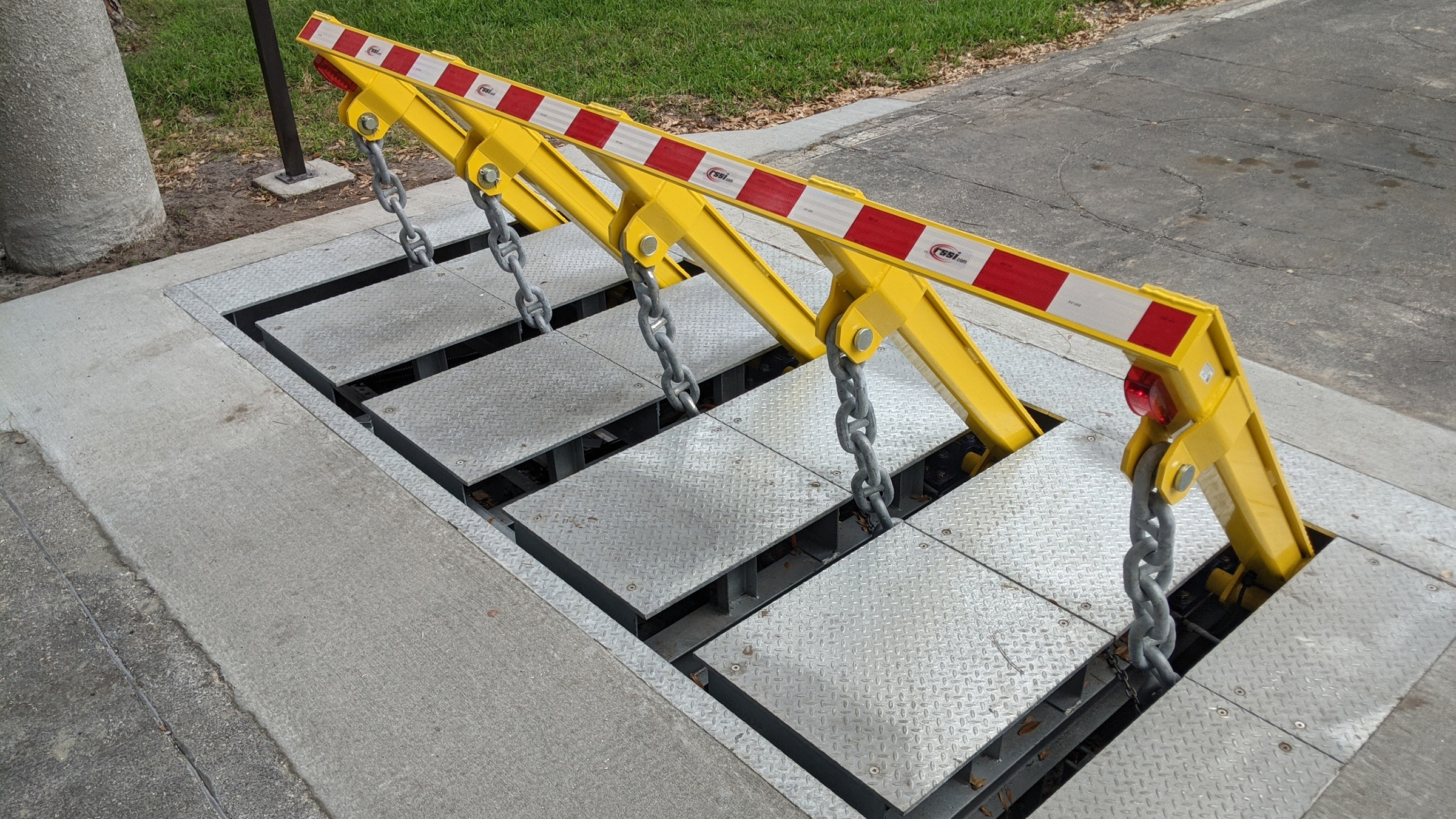Things about Wedge Barriers
Wiki Article
The Best Guide To Wedge Barriers
Table of ContentsThe 8-Second Trick For Wedge BarriersSome Known Factual Statements About Wedge Barriers

14 and the surface area 12 to which the barrier 10 is protected might be made from concrete - Wedge Barriers. 2, the barrier 10 is installed to or includes a support or subframe (e. g., support 30 revealed in FIG. 2 )safeguarded underneath the surface area 12. For instance, the bather 10 might be bolted to the anchor or secured to the support by various other mechanical fasteners. In the detailed personification, the obstacle 10 consists of a wedge plate 16, that includes a portion that is considerably parallel with the surface 12 when the obstacle 10 remains in the retracted placement. To put it simply, automobiles or people might pass over the barrier 10 when the obstacle 10 remains in the pulled back setting and experience small elevation about the surface area 12 while on the obstacle 10. As gone over carefully listed below, when the obstacle 10 remains in the released placement, the wedge plate 16 is held and sustained in a raised placement by a training device of the obstacle 10. Furthermore, the components 18 might be bolted or otherwise mechanically coupled to one an additional. In this manner, fixing or substitute of one or even more elements 18 might be streamlined and streamlined. That is, repair work or replacement of single parts 18 may be done more rapidly, easily, and expense effectively. FIG. In specific personifications, the anchor 30 might be a steel frame consisting of plates, beam of lights(e. g., I-beams ), and/or other frameworks that are safeguarded within the structure 14, which may be concrete. At the surface 12, an upper side 28 of the anchor 30 might be at the very least partly subjected , consequently allowing the add-on of the obstacle 10 to the support 30. g., threaded openings)in one or even more light beams or plates of the support 30 may be exposed to the surface 12. In this way, screws 32 or various other mechanical fasteners may be used to safeguard the barrier 10 to the anchor 30. As the barrier 10 is mounted to the surface 12 of the structure 14, collection of particles and various other product underneath the obstacle might be decreased, and parts of the bather 10 may not be subjected to listed below quality atmospheres. As indicated by recommendation character 52, the lifting mechanism 50 consists of components got rid of underneath the wedge plate 16. For instance, the components 52 below the wedge plate 16 might consist of an electromechanical actuator, a webcam, one or even more camera surfaces, etc. In addition, the lifting mechanism 50 includes a spring setting up 54
The springtime rod 58 is paired to a web cam(e. g., camera 80 revealed in FIG. 4) of the lifting system 50. The springtimes 60 disposed regarding the springtime pole 58 are kept in compression by springtime sustains 62, consisting of a fixed springtime assistance 64. That is, the fixed springtime assistance 64 is fixed family member to the foundation 14 et cetera of the bather 10.
Wedge Barriers Fundamentals Explained
g., spring assistance 65 )might be fixed to the end of the spring rod 58 to make it possible for compression of the springs 60. As the springtimes 60 are compressed in between the spring sustains 62, the springtime assembly 54 produces a pressure acting on the camera combined to the spring pole 58 in a direction 66. As an example, the staying pressure used to the camera to deploy the wedge plate 16 may be provided by an electromechanical actuator 84 or various other actuator. Because of this, the spring setting up 54 and the actuator 84(e. g., electromechanical actuator)may run together to convert the camera and lift the wedge plate 16.
As mentioned over, the spring assembly 54 applies a consistent force on the web cam, while the electromechanical actuator may be regulated to put in a variable force on the cam, consequently making it possible for the training and lowering( i. e., releasing and withdrawing )of the wedge plate 16. In certain personifications, the consistent pressure used by the springtime assembly 54 might be adjustable. g., electromechanical actuator) is impaired. As will certainly be valued, the springtime assembly 54 may be covered and secured from particles or other aspects by a cover plate(e. g., cover plate 68 displayed in FIG. 4) that might be considerably flush with the raised surface 38 of the structure official source 14. As stated above, in the released setting, the wedge plate 16 offers to obstruct accessibility or traveling past the Click Here barrier 10. The barrier 10(e. g., the wedge plate 16 )might obstruct pedestrians or cars from accessing a residential property or path. As talked about above, the obstacle 10 is connected to the anchor 30 secured within the foundation 14,

front braces 71. As an outcome, the link settings up 72 might pivot and turn to allow the collapse and extension of the linkage settings up 72 throughout retraction and deployment of the bather 10. The affiliation settings up 72 cause motion of the wedge plate 16 to be restricted. For instance, if a car is traveling in the direction of the deployed wedge plate 16(e. For instance, in one scenario, the safety and security legs 86 may be expanded throughoutmaintenance of the obstacle 10. When the safety and security legs 86 are deployed, the safety and security legs 86 support the weight of the wedge plate 16 against the surface area 12. As a result, the training device 50 may be shut off, serviced, gotten rid of, replaced, and so forth. FIG. 5 is partial viewpoint view of an embodiment of the surface-mounted wedge-style barrier 10, highlighting the web cam 80 and the webcam surface areas 82 of the training system 50. Especially, two webcam surfaces 82, which are referred to as lower webcam surface areas 83, are positioned listed below the web cam 80. The lower cam surface areas 83 might be dealt with to the surface area 12 (e. For example, the lower cam surface areas 83 and the mounting plate 85 may develop a solitary piece that is protected to the support 30 by screws or other mechanical bolts. Furthermore, 2 camera surfaces 82, which are described as top cam surfaces 87, are positioned over the cam 80 and paired to (e. In various other personifications, interfering layers or plates may be placed in between the surface 12 and the reduced web cam surface areas 83 and/or the wedge plate 16 and the upper camera surfaces 87 As pointed out above, the camera 80 translates along the camera surfaces 82 when the wedge plate 16 is lifted from the withdrawed setting to the released position. In addition, as mentioned over, the springtime assembly 54 (see FIG. 3 )might provide a force advice acting upon the cam 80 in the instructions 102 using spring pole 58, which might decrease the force the electromechanical actuator 84 is required to put on the cam 80 in order to actuate and raise the wedge plate 16. 1 )to the deployed setting(see FIG. 4). As revealed, the web cam 80 includes track wheels 104(e. g., rollers), which get in touch with and translate along the camera surface areas 82 throughout operation.
Report this wiki page